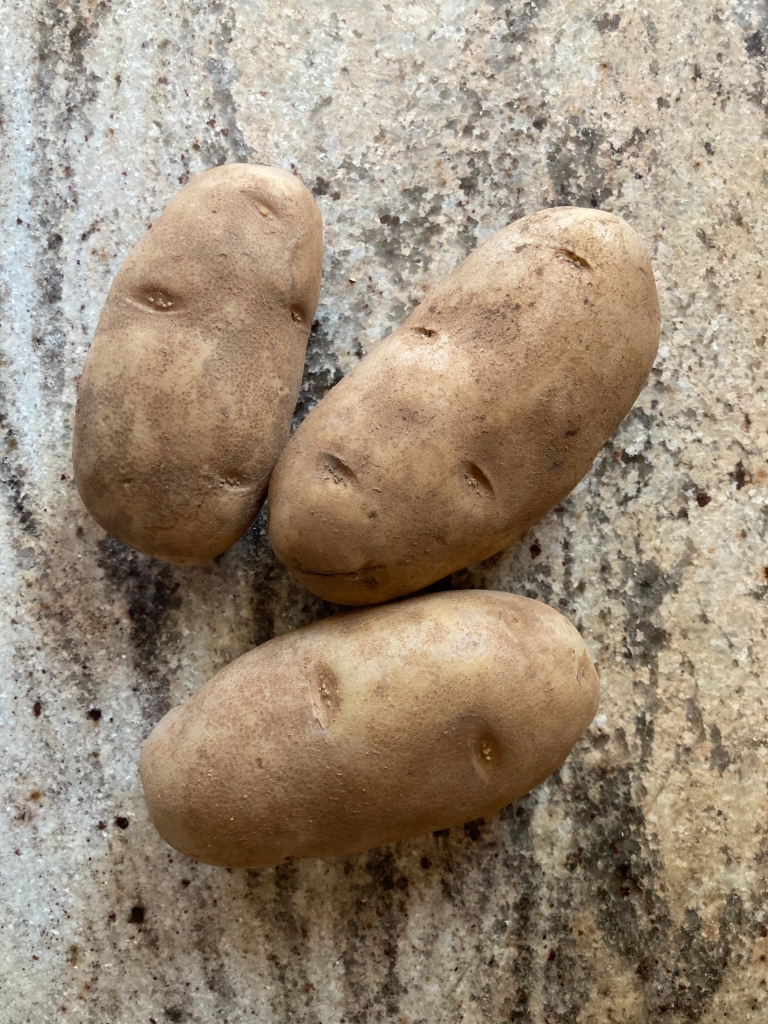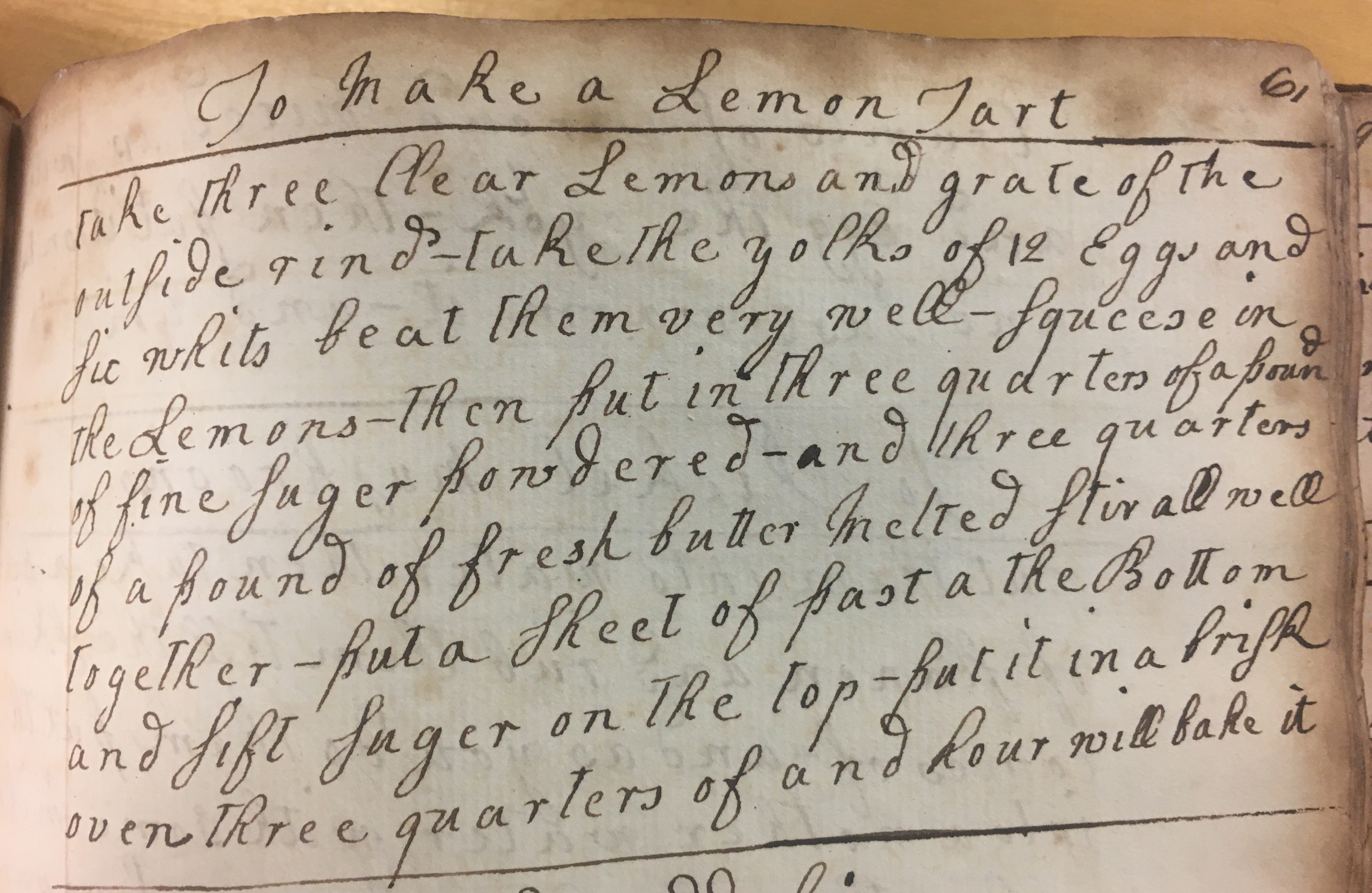Should a pudding be sweet or savory? Where do American and British definitions of pudding and pie overlap and diverge? And, most importantly for this post, what place does the potato – or sweet potato – have in pudding and pie recipes?
All of these questions were on my mind a few weeks ago when I first read this recipe for “A Potatoe Pudding” from the Browne manuscript at Penn State. Although the recipe title calls this dish a pudding, I think it also fits the American definition of a pie because it consists of a pastry crust and a creamy potato-based filling. As a sweet dessert, it fits the capacious, British definition of pudding and it is similar in some ways to classic British desserts (such as Bakewell Pudding). It is also reminiscent of American sweet potato and pumpkin pie recipes because it combines mashed vegetables with dairy, sugar, and seasonings.
Pie was on my mind because Christina Riehman-Murphy and I were planning to bake a potato pie for the Folger Shakespeare Library and UCLA Libraries’ Great Library Pie Bake-Off. First, Clara Drummond helped us access images of the recipe book at Eberly Family Special Collections. (They will hopefully be available online soon!) When I read this recipe and I realized that it would be perfect for the event. I collaborated with Christina on interpreting the original recipe and writing an updated version. Christina was the baker representing PSU in the competition and this post includes some of her findings from baking the recipe as well as my own.
The Browne recipe book was compiled in the late eighteenth century and early nineteenth century. This recipe for a potato pudding speaks to a moment when European cooks were trying to make sense of where indigenous American ingredients – both sweet and white potatoes and particular cultivars thereof – fit into established cookery traditions. Was is best to include potatoes in sweet dishes or savory ones? How would their gorgeous sweetness and earthy flavors best compliment European ingredients?
(I also baked a Lemon Tart from the Browne manuscript for The Great Rare Books Bakeoff last summer. Stay tuned for details about the 2021 competition!)
Original Recipe

A Potatoe Pudding
Miss Ruttons
Half a Pound of Butter, a Pound of
Sugar, Four Lemons, juice & Peel mix
these well together & then put one
Pound and a half of Potatoes mashed
to them. – Put a Puff Paste at the
Bottom of the Dish.






The recipe is relatively straightforward. It instructs you to season cooked, mashed potatoes with butter, sugar, and lemon juice and peel and bake this filling in a dish lined with pastry. After trial and error, Christina and I determined that the pie achieved more structural integrity with a blind-baked crust. This prevented the dreaded soggy bottom. Since there are no eggs and milk to bind the filling, mine came out rather damp. In classic recipes for sweet potato pie (and even pumpkin pie), the mashed vegetable filling is a custard that relies on eggs and milk for structural integrity.
Updated Recipe
Halved from the original. You can also prepare both the crust and filling in advance and bake the pie from room-temperature ingredients. Christina found that a cooler potato-filling led to a pie that set better during baking.
8 Tablespoons butter at room temperature (1 stick, 113g)
1 1/8 cups sugar (226g)
2 lemon, juice and zest
2.5 cups of chopped potatoes (¾ lb, 678g)
A batch of your favorite homemade or store-bought puff pastry or pie crust.
Preheat oven to 425°F/218°C
Make or buy pastry.
Grease a pie or tart dish with butter or baking spray.
Roll out the pastry on a floured surface. Arrange pastry in baking dish.
To blind bake the crust, cover the pastry with foil and fill the dish with baking beans or another weight.
Bake at 425°F/218°C for 12 minutes. Reduce the temperature to 350°F/180°C for 10 minutes. The crust should be golden and set, but not as brown as when a pie is completely finished baking. Keep the oven at this temperature for baking the pie.
While the crust is in the oven and cooling after blind baking, prepare the filling.
Peel the potatoes. Chop them into small cubes. Boil them until they are cooked and tender (about 15 minutes). Drain off the cooking water using a colander. Juice and zest the lemons. Put the cooked potatoes, sugar, and butter in a sturdy bowl. Mash the potatoes and integrate the butter and sugar into the mix. Make sure there are no lumps of butter or potato. Stir in the lemon juice and zest.
Pour this mixture into the prepared pie crust.
Bake for 35-40 minutes until the pastry is brown and the filling sets. Cool before serving.

The Results
Christina and I agreed that the finished pie tastes much more like a lemon pie than a “potato pie.” In this preparation, the natural sweetness of the potatoes offsets the sharp flavors of citrus juice and zest. This dish was unlike any other potato-based pie or pudding I’ve ever consumed. Personally, I found the recipe very interesting, but I didn’t particularly enjoy eating it. I’m happy to report that the pie was a hit at Christina’s house (especially as breakfast). And while pie for breakfast may not be part of any “official” British or American culinary traditions, a slice of my mom’s pumpkin pie and a cup of coffee is my favorite breakfast the day after Thanksgiving.












You must be logged in to post a comment.